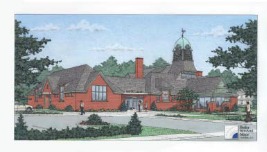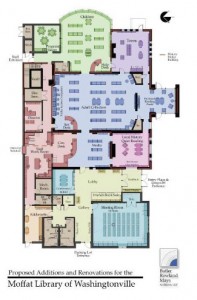 Historic Moffat Library
Historic Moffat Library
Timeline
1880 Building Constructed
1950’s Library Expansion
1970’s Town Recreation Department Expansion
1990’s Library Expansion
2011 Hurricane Irene forces Library Relocation to Temporary Space
2012 Town of Blooming Grove transfers ownership of Moffat Building to Library Board of Trustees
2013 Library Board acquires two adjacent properties on West Main Street
2015 March 3, 2015: Public Referendum for the Additions and Renovations to the Moffat Library of Washingtonville
Questions & Answers
Download our: Q&A Brochure-013015 Download our: Plan for Moffat Library Brochure
Why is the library in a temporary location?
Building damage from Hurricane Irene forced the Library to relocate to a temporary space generously provided by a local business person. Although the water in the basement and mold issues were addressed, the roof damage was never repaired. The areas of the building that were used by the Town are in need of major repairs.
Did the Library get any money from FEMA after Hurricane Irene?
The library did not receive any money from FEMA. At the time of the flood the library was owned by the Town of Blooming Grove. The Town had insurance on the building and the insurance money paid for the cleaning of the mold in the basement and the replacement of the furnace.
Will the renovated library be safe from future flooding problems?
The flood levels of the proposed additions will be raised above grade to match the historic Moffat Hall, which is several feet above the highest flood level. The additions will not have basements or crawlspaces, and the existing historic basement will not have any mechanical systems. A sump system will be installed, should small scale flooding occur.
How will the Library sustain and maintain an enlarged Library building?
When we were looking at different design concepts with the architects, we were very cognizant of keeping future costs to a minimum. The open floor plan design we chose enables minimal staff to monitor multiple areas. In addition, by installing new energy efficient building systems, we can minimize energy costs and maintenance. This design plan was developed with an eye towards keeping the cost of constructing the building down, keeping future maintenance and staff costs down and maximizing the use of the space to provide the community with the services it depends on.
How was an architectural firm selected?
The Board of Trustees formed a building committee made up of members of the Board and residents of the Town. The committee visited many new and restored libraries in the surrounding area. Research was done to find architectural firms with experience in library design and historic restoration. After a thorough process of qualification reviews, interviews and presentations, the firm of Butler Rowland Mays Architects, LLP was chosen. Their lead architect for our project, Paul Mays, specializes in designing libraries and has extensive experience in doing historic restorations.
What can we expect to have in our restored and revitalized library?
A major survey was conducted by the staff of the Library to assess the needs and wants of as many patrons as possible. Our Architect Paul Mays led two community meetings where ideas and concerns were solicited. The building committee, the Library staff and the Library Board also developed a list of what they felt the building should have to meet the growing needs of our community in the 21st century. The final design incorporates most of these suggestions while maintaining a responsible budget.
Our renovated and expanded building will include the following features:
- Dedicated Children’s Room
- Children’s Activity Space
- Teen Program Space
- Glassed-in Adult Quiet Reading Room
- Conference Room for Tutoring or Home Office Meetings
- Community Meeting Room for up to 64 people
- Local History Room
- Friends of the Moffat Library Book Sale Space
- Kitchenette for Event and Staff Usage
- Sustainable Design Features
- Park-like landscaped setting
- Ample Parking for 30 Vehicles
When will construction begin and when will the building be finished?
Preliminary design work is currently underway. A successful referendum will allow construction to commence the Summer of 2015 and be completed by November 2016.
What will the project cost and how will it be financed?
A fundraising campaign has begun and to date we have raised $621.991. We are also applying for grants which will defray some of the costs. There will be a vote on a bond issue on March 3, 2015 at the Moffat Library temporary location. The Library will be seeking to borrow up to $6,922,000. Our financial advisors have indicated that on an average house with a fair market value of $250,000-$300,000, the yearly cost will be $55-$80 ($0.15 -$0.22 per day) or $2.00 per week, the cost of a cup of coffee. Any amounts we are able to raise will reduce the final amount we actually need to borrow. The total cost for the project is expected to be $7,422,000.
The Library has designated $500,000 from its building fund for the renovation project. Where did the Library get this money?
The Library Board of Trustees set up a building fund and budgeted money for future needs. The Trustees anticipated needing money to repair and renovate the building after so many years of delayed maintenance. In addition, after relocation to the Route 208 site, the Trustees anticipated paying rent and budgeted money for this expense. During the first year at the Route 208 location, the owner did not charge rent. When it became apparent that return to the Moffat building would be several years away, a lease was signed and the Library now pays rent. Therefore, the prudent anticipation of major expenses and needs has resulted in the Library now being able to use its reserves towards the building fund.
What sustainable design features and energy efficiencies will the new Library have?
The Library Board and Design Team are committed to creating an environmentally friendly and responsible building. Some of the features will be:
- A mechanical system (HVAC) featuring high-efficiency boilers, variable speed motors, energy recovery units and high efficiency air filtration.
- High efficiency interior and exterior light fixtures set with occupancy sensors or timers
- A more comprehensive list can be found on Moffat Library’s website (moffatlibrary.org).
What can I do to help the Library?
You can:
- Consider joining the Friends of Moffat Library if you are not already a member. Call 496-5483 ext. 323.
- Consider hosting a coffee with your friends to learn about the new Library
- Make your donation to the building fund. Ask about Naming Opportunities.
Is the Library getting any money from the New York Rising funds that the Village of Washingtonville is to receive?
The Library has been informed that they should not expect to receive any New York Rising funds. The Village & Town of Blooming Grove are combining their NY Rising funds & using the combined monies for studies of the Moodna & developing flood mitigation projects. The Library is not expecting to receive any NY Rising funds. Should the Town & Village alter their plans for use of the money and the Library then receives any funds, this amount would be deducted from the amount the Library actually borrows. The bond amount of $6,922,000 sets the maximum amount the Library can borrow. Any $ acquired through grants, NY Rising monies or fundraising efforts will reduce the amount borrowed.


